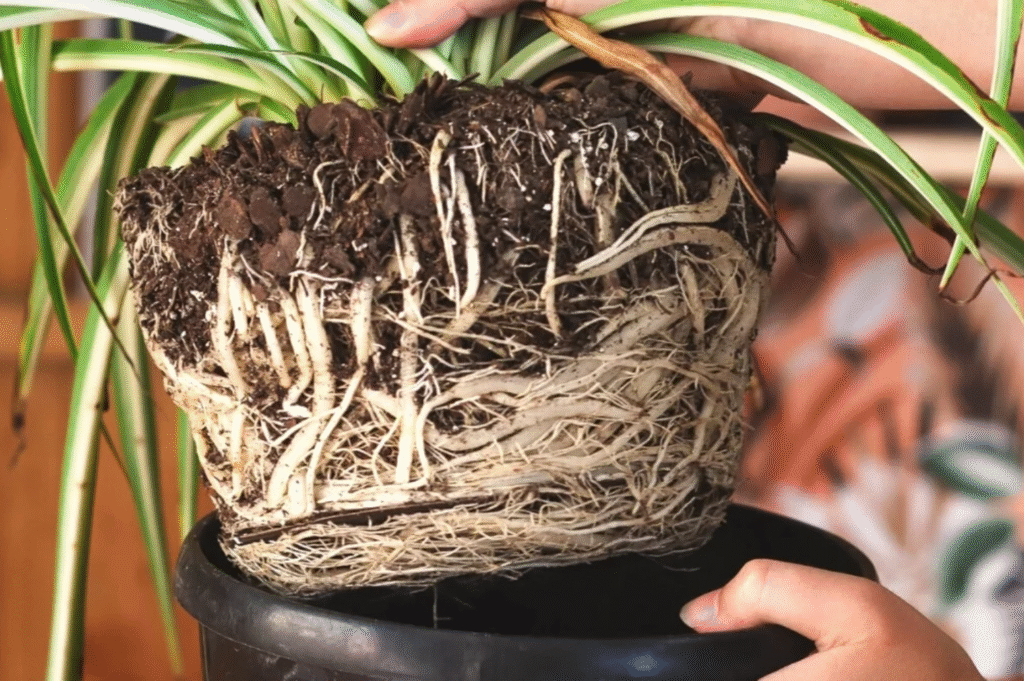Spider plants (Chlorophytum comosum) are one of the easiest and most forgiving houseplants you can grow. They adapt well to different environments and don’t require much fuss. But when it comes to pot size and root space, many plant owners wonder, “Do spider plants like to be root bound?”
In this article, you’ll learn whether spider plants prefer tight pots, when to repot them, and how to spot signs that it’s time for a bigger home.
Do Spider Plants Like to Be Root Bound?
Yes, spider plants enjoy being slightly root bound. They tend to grow better and produce more baby spiderettes when their roots are a little crowded. However, if the roots become too cramped, it can affect the plant’s health. Repot when the roots start circling the pot or growing out of drainage holes.
What Does “Root Bound” Mean?
A plant is root bound when its roots outgrow the container and start wrapping around the inside of the pot. In some cases, the roots can become tangled, dense, and even poke out from the drainage holes.
Some houseplants dislike being root bound and will stop growing or show stress, but spider plants are surprisingly tolerant of it.
Do Spider Plants Prefer Tight Pots?
Spider plants generally prefer being in slightly snug pots. When their roots fill up the pot, they often focus energy on producing flowers and baby plantlets (spiderettes). This is why you’ll sometimes see spider plants sending out long runners filled with little plant babies when they’re a bit root bound.
That said, overly cramped roots can lead to issues like:
- Poor water drainage
- Root rot
- Slower growth
- Yellowing or droopy leaves
Signs Your Spider Plant Is Too Root Bound
While spider plants like snug pots, there’s a limit. Here’s how to tell if your plant has outgrown its home:
- Roots poking out of the drainage holes
- Water running straight through the pot without soaking the soil
- The plant drying out faster than usual
- Cracked or bulging pots (if plastic)
- Stunted growth or drooping leaves
If you notice these signs, it’s time to consider repotting.
When Should You Repot a Spider Plant?
Most spider plants need repotting every 1–2 years. The best time to repot is during the spring or early summer when the plant is actively growing. If you’re new to spider plants, understanding the fundamentals of their growth and care will make the repotting process much smoother.
Choose a pot that’s 1-2 inches wider than the current one. Avoid selecting a pot that’s too large, as excess soil can stay wet and lead to root rot.
Can Being Too Root Bound Harm a Spider Plant?
While spider plants tolerate tight roots, being severely root bound for too long can cause problems, such as:
- Root rot due to poor soil drainage
- Nutrient deficiencies
- Drooping or yellowing leaves
- Reduced production of baby plantlets
Keeping an eye on your plant’s root health and repotting when needed ensures it stays lush and thriving.
Conclusion
So, do spider plants like to be root bound? The answer is yes, to a point. They perform well in slightly crowded conditions, which can even encourage them to produce more spiderettes. But if the roots become too packed, it’s important to repot your plant into a slightly larger pot to avoid health problems.





